- Home
- Osteoporosis
- Smart Bran
Smart bran
Smart bran asks what the research says about this byproduct of the milling of wheat and oats.
I will admit it up front that this page is about the best ways to get extra fibre into your diet and has nothing to do with the brand name.
It is the fibre that will concern your chiropractor because of the increased risks of osteoporosis due to inhibition of calcium absorption from extra, added bran.
Note here the emphasis is not on bran per se. It's about that which is extra; added on.
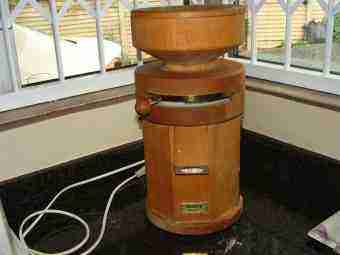
Dietary fibre comes in two forms; one is from the bran of grains, and seeds too. The other is soluble, for example the pectin in an apple. They absorbe water and swell in the gut giving the stool bulk. Both are necessary for a happy colon.
Although they are in fact carbohydrate, they are not absorbed in the small intestine along with other starches; they pass through to the colon.
They do not contribute to "net carbs." They are known as "resistant starches."
In addition they affect how the substances in food are absorbed; for example, if you have adequate fibre in your diet, blood cholesterol will be far less of a problem. You can have your butter and eat it, so to speak.
Probably the most important effect of fibre is to give the stool easy passage through the intestine; it makes for soft faeces and stops constipation dead in its tracks. That is why it helps prevent diverticulosis, haemorrhoids and colorectal neoplasms; all of them are nasties to be avoided at all costs.
- Over the counter treatments for chronic idiopathic constipation should start at the greengrocer, not the pharmacy, recommend the scientists.
It is of importance in chiropractic too because straining on the toilet is very hard on injured discs in the lower back.
Less than five percent of Americans consume the recommended amount of whole grains which is why there has been a surge of these horrific bowel diseases; it is also central to the heart, stroke and diabetes epidemics that are killing 1000 people every day in the US, needlessly because of a poor diet lacking in fibre.
In a very real sense those relying on typical food from the grocery store, what is known as the "industrial diet," are often malnourished; lacking in fibre.
Herein lies the catch laid bare by the researchers who have published in the Journal of the American Medical Association; all is not as it seems. So-called "wholegrain pasta" may not be what you think it is.
Millers are allowed to describe their flour as "whole," even though they have removed up to 40 percent of the goodies; the germ and the bran where the minerals and vitamins are located. It is definitely no longer the nutritious stuff that is recommended by nutritionists.
How this anachronism ever arose is a mystery, but certainly it enables food manufacturers to mislead us into believing that their products are the good stuff. Of course we, the public, are at least partly to blame; our palates have become accustomed to bread that is soft and easy to swallow. Often we abhor 100 percent whole grains; they are chewy. Pass me a white roll please.
Millers claim they are simply providing us with what we want; still, to mislead and deceive us into believing their wholegrain in fact contains 100 percent of the wheat is disingenuous beyond belief.
Smart bran
The dietary deficiency of fibre has become a topical subject since the USDA stated that our requirements are in essence that at least 50 percent of the wheat must be "100% whole grain."
It matters not apparently that the other half can be cake flour; tasteless so large amounts of butter, eggs and sugar have to be added.
You can read about it by googling the whole grains council website. Smart bran is just one part of this blurring of the facts.
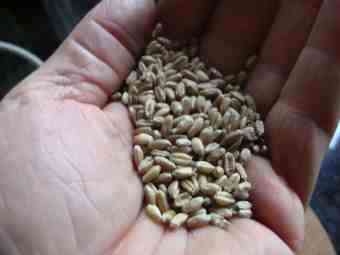
Smart bran is the brand name for a cereal that is made from wheat, oats and psyllium; 20 percent of the product is added sugar to make it palatable. They describe that as a "light touch," but at one fifth it is misleading.
This is not a wholegrain; it is made only from the bran. The germ and endosperm have been extracted.
One helping also contains 5 percent of the recommended dietary allocation of salt; that is not high in itself, but considering that we mostly consume far too much, it is one more nail in the coffin.
There is nothing intrinsically wrong with the ingredients in smart bran, other than the sugar and salt; but they should be consumed as part of the 100 percent whole grain, researchers at JAMA recommend, rather than as an added cereal.
Smart bran added to a diet of refined grains has much less of a beneficial effect. Rather enjoy 100 percent wholewheat bread; if you can find it. Just one slice contains 5 to 7g of fibre, about one-fifth of a woman's total daily requirement. Men need nearly twice that.
Dr Alice Lichtenstein recommends in the JAMA research that we do not judge a grain or cereal by its colour. Food companies like to deceive us by adding caramel or other chemicals to darken it; rather read the label searching for terms such as "100 percent whole wheat."
The fibre in our diet is not only obtained from grains but also from fruit and vegetables; nuts and seeds too. The average American diet contains about 15 grams per day which is totally inadequate; less than a half of what is recommended.
The researchers in the JAMA study have been following two groups of people, totaling over 100,000 for over 25 years. Adding just one ounce, 28 grams of whole grain to the diet, less than one slice of bread, has decreased the overall mortality by 5 percent and from heart disease by nearly double that.
Better still, if you substitute a 100 percent wholewheat slice for white bread, then that five percent drop in overall mortality jumps to 8%.
Substituting a serving of whole grain for one of red meat and you will have a massive 20 percent drop in cardiovascular mortality; that is apart from the reduction in bowel diseases like colorectal neoplasms and diverticulitis.
Returning to our fibre story, Dr Lichtenstein points out that simply adding smart bran, for example, to a diet which is high in refined grains like white bread and pasta yields no benefit.
Sadly you cannot have your cake and eat it; adding smart bran yields no benefit.
She recommends we look out for 100 percent whole grains, and perhaps add more smart bran to that; the latter I cannot endorse because of the effect on calcium and pyridoxine absorption.
If you bake your own bread, finding 100 percent wholewheat flour will be difficult. Purchasing a loaf like this from your supermarket is virtually impossible in many countries.
The best way to resolve this problem is to purchase a wheat grinder and mill your own wholegrain flour.
If you are going to purchase a bread machine, then I recommend you go the whole hog and get that wheat grinder too; otherwise you are likely to join the great mass of people who never use it.
The bread machine is apparently the most unused appliance in the kitchen.
What may come as a surprise is that takes only six minutes to grind your own healthy flour and prepare the dough such as for the panera bread menu recipe; then of course it takes a minimum of five hours to rise, prove and bake.
The bran in your 100 percent wholewheat contains the lignans which block the hormone receptors in the breast, protecting them against high levels of circulating oestrogen.
Researchers found that oats, wonderful healthy grain that it is, and corn bran did not supply the protection against breast and bowel tumours that wheat gives.
"Increasing whole grain consumption in daily dietary structure is a practical strategy for breast cancer prevention."
- Nutrients, 2019 Aug
Healthy flour
In short get your smart bran by grinding your own healthy flour; it will mean finding a source of wheat. If you bake three or four times a week, you'll need two large 50kg bags per year.
Be careful of lifting them or you will be seeing more of your chiropractor. We move it as soon as possible to a dedicated deep freeze for two weeks to kill the weevils.
JAMA also reports by the way that consuming 100 percent whole grains is also associated with a lowered risk of getting type-2 diabetes.
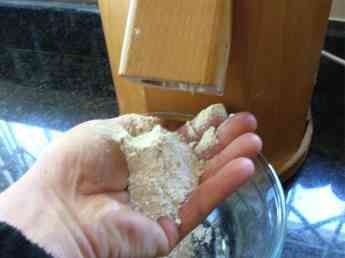
"We observed a significant inverse association between total dietary fiber intake and the risk of diabetes; of the different sources that from cereals was most strongly associated with decreased risk."
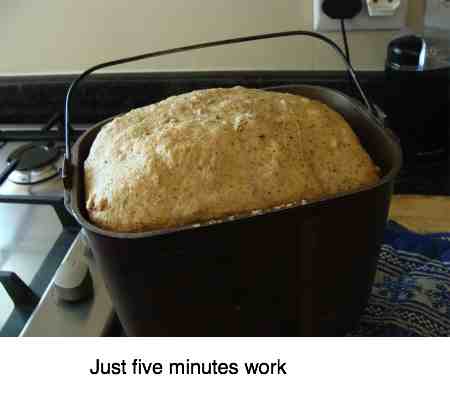
Vitamin B6
B6, also known as pyridoxine, comes in eight different forms in many diverse foods. Researchers reporting in J. Nutr have shown that adding extra cooked bran to the diet depresses the plasma levels; instead the vitamin is excreted in the faeces[1].
Ironically one of the forms of B6 is found in the bran; but adding extra inhibits the others.
Added seeds
Added seeds, provided they are first ground, provide substantial smart bran to your daily slice of 100 percent wholewheat bread. Many like flax and sesame pass through the gut undigested, the fibre useless, and in fact may get stuck in diverticuli; you must grind them first.
The solution is a small, inexpensive coffee-grinder. I prepare enough for a week and keep it in the fridge.
A vegan seed-bread is very simple to prepare. The nutty flavour of sunflower and even almonds makes it a delight; if you can add them after an hour or more it rises better.
Added seeds definitely impede the normal rising of the dough; we enjoy them in our smoothies and on salads rather.
Most margarines have toxic trans fats by the way; researchers combining 80 of the best research projects on cholesterol find absolutely zero scientific proof that there is any benefit moving away from butter even if you have heart disease.
In short butter is back, thank goodness, many of us sigh; margarine is so awful. In chiropractic we are pleased about that; natural unprocessed fats to line the nerves.
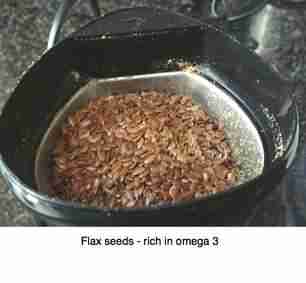
100 percent whole wheat
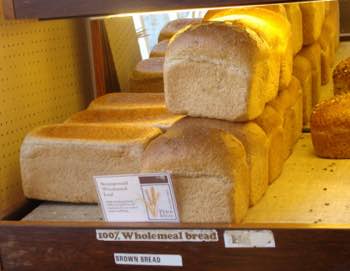
Getting your smart bran from 100 percent whole wheat does create other logistical difficulties. Some would say we are bordering on fanaticism; perhaps so, but having witnessed the miserable death from colorectal cancer of a chiropractic colleague in our practice who ate only white bread and processed meat for lunch, I have become obsessed with not going down that road.
We heartily endorse the "real bread" revolution that is sweeping through Britain; apart from anything else, it tastes so much better.
Weevils will attack that 100 percent whole wheat; they relish the germ where all the vitamins and minerals are stored. The only sensible solution is to keep a freezer dedicated to your natural whole grains. Because it is only occasionally opened, we power it only during the day when the sun is providing free energy. Refrigeration using solar power is not rocket science.
Alternatively it must be poisoned with phostoxin, or some similar noxious substance; or your supplier must freeze it for two weeks; even in the fridge it seems to be fine.
Look for the 100% sign
Look for the 100% sign when buying bread; otherwise you should add smart bran to your diet.
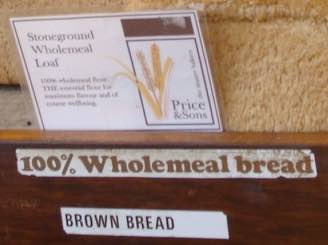
You are not likely to find this in any supermarket; you will have to hunt for it, or bake it yourself. Be prepared to pay more, because it is worth the extra.
On the other hand because it is only ground and not processed, it is far less work for the miller; but he cannot then sell the best parts, the germ and bran, to vitamin companies and pig farmers.
You are not likely to have visited Ludlow in England, but at this little bakery, some seventy years old I believe, still run by the same family, I found the most delicious 100% wholemeal bread. The chiropractor was pleased; I have never seen a shop like this in South Africa, though they abound in Holland.

- Go from smart bran to healthy flour
- Association between dietary whole grain intake and risk of mortality
Nutritious lunch
This nutritious lunch, full of both forms of fibre from the greens and your 100 percent wholewheat bread will supply virtually your total needs for the day. Why add extra smart bran? Chiropractic stands for letting your food be your medicine.
Making your own pesto incidentally is a dream; add avocado, orange peppers and half an egg. It's the perfect meal.
Should you slip a disc, constipation is a huge problem; bearing down on the toilet becomes very painful and aggravates the condition. Chiropractic help recommends a diet high in fibre not just to ease your colon but to improve your overall well-being.
Fiber also gets through to the colon where it supports the microbiome.
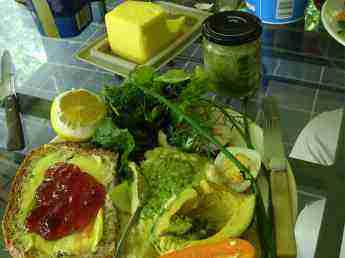
Banting diet
The Banting diet, not dissimilar to paleo, with some important differences, requires a near zero carbohydrate menu; that means no wholegrains so of course no smart bran either.
It remains to be seen whether the Banting diet, restricting all grains including the bran, increases the prevalence of colon disease.
Rather we recommend the Banting diet modified; it does not exclude the nutritious, low GI starches and legumes. We should all give up refined grains for ever in any case.
Lignans
Lignans are oestrogen-like compounds found in many foods but particularly in smart bran and seeds; they have many beneficial effects, one of which is to block the cancerous effect of hormones on the breast. This is vitally important for the chiropractor as every day we are treating women complaining of rib pain.
By limiting the lignans in 100 percent wholewheat by diets prohibiting all carbohydrates we are de-facto promoting breast and colorectal tumours. Lax laws that allow food companies to mislead the public into believing that are eating truly whole grains have the same result.
Is it any wonder that the United States has the highest rate of breast CA in the world?
Wholewheat should mean just that; 100% of the grain with all the constituent parts in the same ratio as in the kernel.
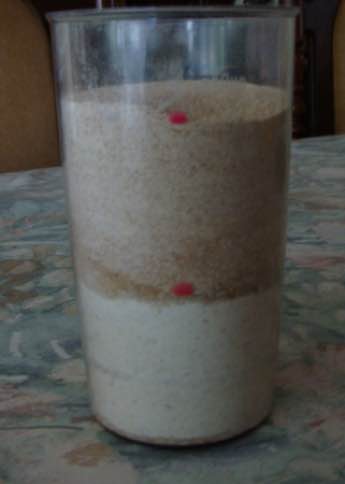
One half is our 100 percent wholewheat flour with all the smart bran, lignans and vitamins; and minerals too.
The other half is described on the packaging as stone-ground wholemeal; I have been on a tour of the mill. Everything is turned into cake flour and then some of the bran is added back.
The deception is obvious; there is no cigar for guessing which is the real McCoy. One prevents large bowel disease and breast cancer; the other just makes you fat.
Chiropractic
Why all this about smart bran on a chiropractic website? Simply because our profession was born out of naturopathy, and we are into better health; that's far more than just fixing subluxations.
Just recently I've been in Holland, and it was with mixed feelings that I was greeted by a patient of old whom I had sent to her doctor; he had belittled that there was anything wrong with her bowel, denigrating me as not a real doctor. It is a story that ends well; three years later he finally conceded to a referral to a specialist who confirmed a colorectal tumour; now she has a stoma.
Think rather of smart bran and more fibre in general in your diet. Remember, less that 5% of Americans enjoy the required amount of whole grain in their diets.
Plus 100% wholegrain is not fattening like your delicious white scones; on high and holy days only.
When browsing these links use right click and "Open Link in New Tab", or you may get a bad gateway signal.
- Home
- Osteoporosis
- Smart Bran
Did you find this page useful? Then perhaps forward it to a suffering friend. Better still, Tweet or Face Book it.
